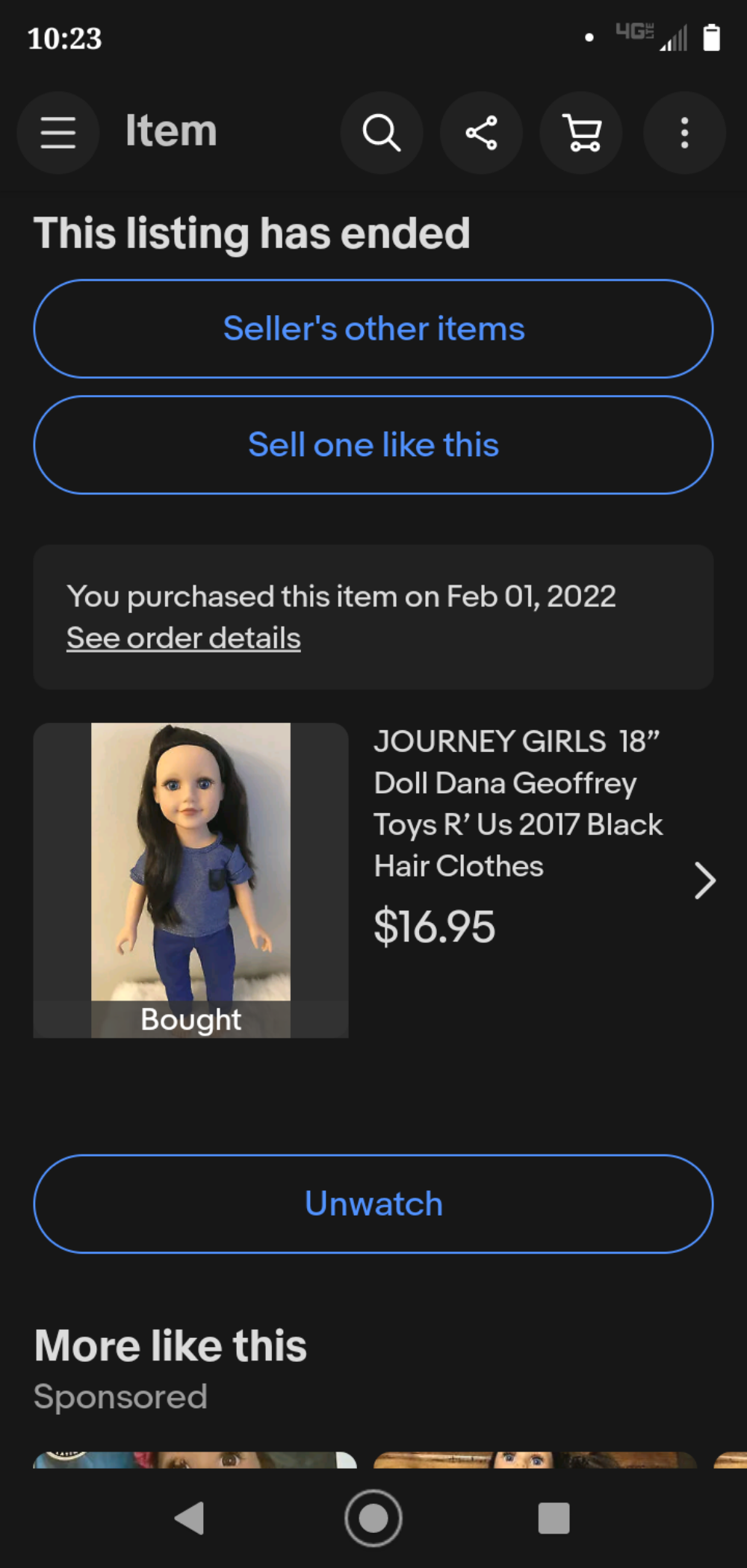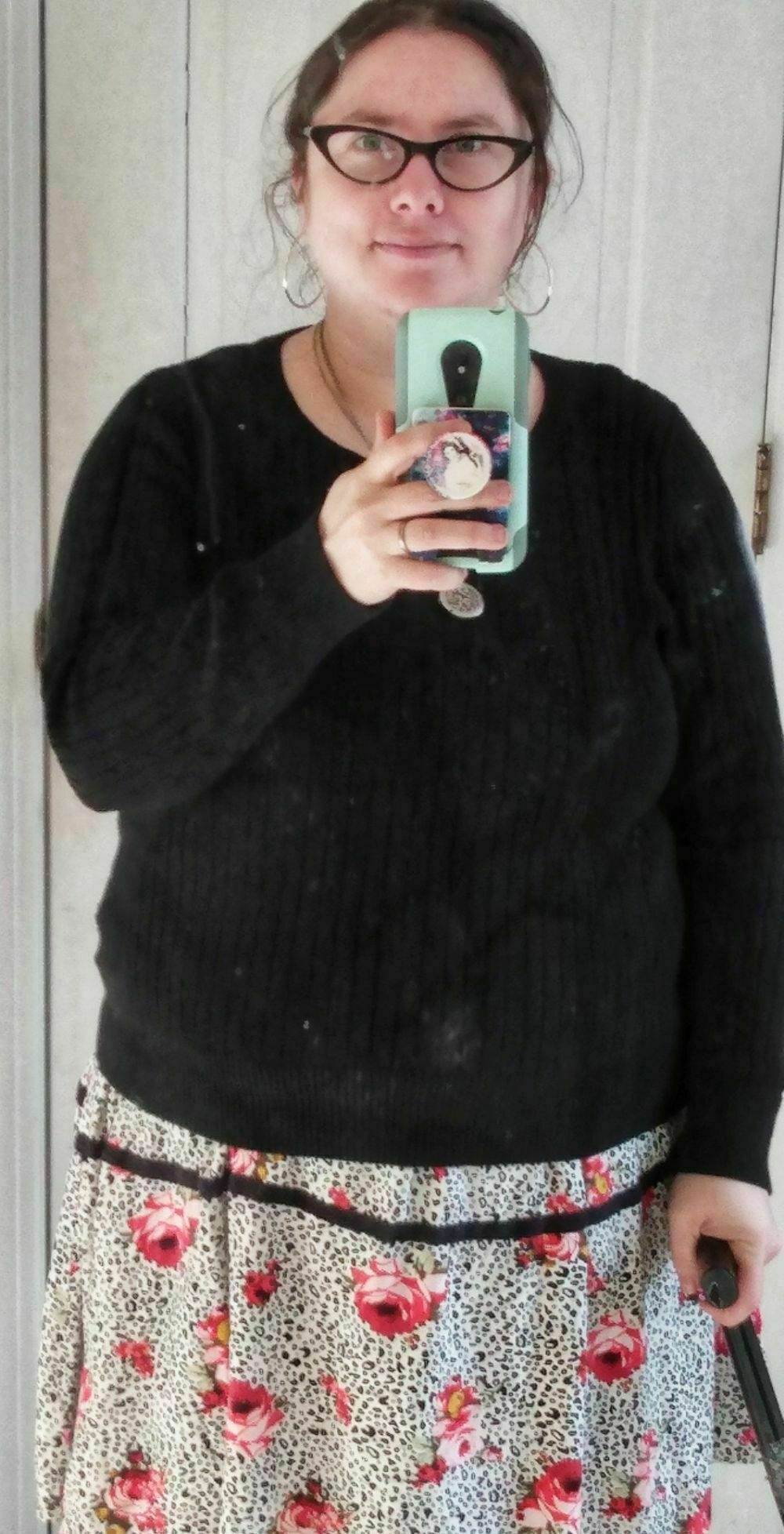February 3, 2022
🔖 Read Women of a Certain Age.
Great piece about how the Golden Age of TV creates space for roles beyond somebody’s mom, somebody’s wife, and harpyish crone. 📺🍿
February 2, 2022
My kid definitely just said “Thwip” in his sleep. 🕸️
The Kimberly urge to write Picard/Gomez fic. 🖖🏻
February 1, 2022
Me, thinking about my mom’s experience with leukemia: The medicine will be what it will be, but what about her feeeeeeelings?
(Never has it been more appropriate that my sun & rising are in Cancer.)
It’s February. Black history is important all year long but February is extra awesome because Black cosplayers show off their stuff daily all month. Search #28daysofblackcosplay on your favorite social media platform to see some amazing cosplay. Learn more at this link.
Welcome to my mid-life crisis.
[Image description: An eBay item page for an 18 inch fashion doll. The page says “You purchased this item on Feb 01, 2022.”]

“People as everyday theorists of their experiences” - great insight from Bill Penuel at the Crown Institute Participatory Toolkit introduction webinar.
January 31, 2022
Feeling cute today.
[A pale white woman with dark hair & blue eyes wears black cat eye glasses, a black cable knit sweater over a white dress with a black jaguar & hot pink rose print, & large silver hoop earrings. She holds a cane in one hand & phone in the other.]

We must be brave enough to look at our own academic systems, if we plan to make them just and equitable. - Kelly J. Baker, Sexism Ed: Essays on Gender and Labor in Academia
💬📚
Hello, I’m Kimberly Hirsh and I just bought and set up creativityforscholars.com. If the domain name intrigues you, why not pop over and sign up for the mailing list?
Me, gathering up all my old dolls that I gave my kid so I can brush their hair: “I know - dolls.” (Oh, Clyde Bruckman. You ask such good questions.)
January 30, 2022
Burnham’s “Let’s fly” is probably the best captain catchphrase but Dal’s “Go fast” might be a close second. 🖖🏻
I just bought the Kindle edition of both volumes of Briana Lawrence’s mixed media magical girl series, Magnifique NOIR, and I am psyched about this magic. Cosmic Green’s outfit is a dream. All the characters are gorgeous. 📚
Encountering a corpse forced the man who would be Buddha to see life as a process of unpredictable and constant change. - Caitlin Doughty, Smoke Gets in Your Eyes and Other Lessons from the Crematory
💬📚
We are all just future corpses. - Caitlin Doughty, Smoke Gets in Your Eyes and Other Lessons from the Crematory
💬📚
The concept of the body as canvas becomes more powerful if the canvas is dead. - Caitlin Doughty, Smoke Gets in Your Eyes and Other Lessons from the Crematory
💬📚
🔖 Read A Counterintuitive Nighttime Routine For The Type A Insomniac.
I love this. I’m constantly trying to Type-A-away symptoms of chronic illness and it Does Not Work.
January 29, 2022
I have a vague feeling I’m at risk of becoming the first victim in the X-Files episode “Clyde Bruckman’s Final Repose”:
Why did this woman collect dolls? What whas it about her life? Was it one specific moment where she suddenly said: “I know: dolls”?
January 28, 2022
Reading misuthewitch’s thesis for my Artist Date today.
[Image Description: A tablet in a purple case displays a paper titled, “Make-Up!: The Mythic Narrative and Transformation as a Mechanism for Personal and Spiritual Growth in Magical Girl (Maho Shojo) Anime.”] 📺

January 26, 2022
Six month check-in: Who am I at 40?
It was my half birthday almost 2 weeks ago, so it seems like a good time to check in on whether I’m being the person I want to be at 40. Here are the intentions I set:
- I think I want to be a little less ambitious about 40, to set fewer goals.
- I want to be a loving and mostly gentle mother.
- I want to take care of my own body, including making clothes built to fit it.
- I want to keep trying new things and growing as a self-employed person.
So how am I doing?
For #1, pretty well. There are a lot of maybes right now. Maybe I’ll submit a paper for that conference. Maybe I’ll go to that webinar. Maybe maybe maybe. This fits in with the need to be super flexible as a caregiver and a person with chronic illness.
For #2, awesome if I do say so myself. My kid definitely knows I love him - and making sure my loved ones feel loved is my highest ambition, if that imagine-your-own-funeral exercise is any indication. I’m also doing pretty well with being mostly gentle. I step away if I’m too frustrated to be kind, saying out loud, “I’m frustrated.” A+, me.
-
I am slowly taking care of my body, though not making any clothes yet. I’ve made having a cup of warm lemon water in the morning a habit and have gotten into a routine of eating nutritious breakfasts that don’t have a ton of sugar in them and meet my target dietary restrictions (eliminate gluten and corn, limit dairy and nightshades).
-
This is another one where progress is happening, but it’s slow. My consulting work for Quirkos is the main way I’ve been doing this. This is on the back burner a bit while I’m doing the postdoc.
Pretty pleased with myself, actually. I’m doing okay.
I’m RSVPing yes to .
Excited to chat about how we track and share book stuff! 📚
January 25, 2022
Okay, world. I’m going to try turning it off and then turning it on again, “it” being this day.
More than a little psyched about Emily Vardell & Sarah Beth Nelson’s paper Teaching Reference Interview Skills with Improv.
🔖 Read The Only Work Ethic I Care About is the One on Star Trek
Yes! When a 20th c guy ends up on the Enterprise and is all “What am I supposed to do if I don’t need to make money?” Picard is basically like, “Grow.” ❤️ 🖖
When is a gap not a gap? Doing research that hasn't already been done
An undergrad sent me a message thanking me for my post A Start-to-Finish Literature Review Workflow and asked the question:
Is there an exhaustive way of making sure that the literature gap you have identified is genuinely a gap?
The short answer is, no. There isn’t. But there are ways to get close.
In my experience, the best way to begin is with a specific research topic in mind, but before you have fully developed a question. You get familiar with the literature using the tips from step 4 in my workflow: Identify potential literature.
- Consult with a trusted colleague.
- Search databases.
- Search Google Scholar.
- Follow citations backwards.
- Follow citations forwards.
After you look at the abstracts for these and eliminate the ones that are outside the scope of your topic, pay close attention when you’re doing your Abstract-Introduction-Conclusion extraction reading to suggestions for future research. In my experience, this is the most fruitful way to find gaps. Both my Master’s paper and dissertation research questions were suggested in the future research section of other scholars’ work.
As H. L. Goodall says in Writing the New Ethnography,
To locate a gap in any scholarly literature requires that you read a lot. (emphasis original)
Goodall offers some more specific advice as well:
- Start with the most recent literature.
- Notice which things are referenced repeatedly - the references all the most recent work has in common.
- Make a chart of names, relationships to institutions, and arguments.
- Look for patterns of citations, themes, and topics.
I don’t think I can give better advice than that. I’ll close out with more from Goodall:
You are reading for the storyline. You may not be sure what you are using it for, at least not yet. But that is all right. Be patient. Ideas, and uses for them, often take time.
You are also reading to find out what is collectively written about an idea, what individual voices have to say about that collective idea, and for an opening that you can address.
There’s no shortcut, I’m afraid. You have to jump into the literature before you know what the gap is. When everything you’ve read is referencing everything else, it’s safe to trust you’ve got a good sense of the topic and know where the gaps are.